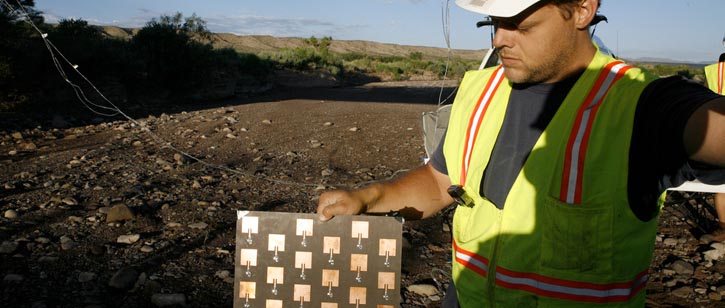Sensors, Instrumentation Systems
National security depends on science and technology. The United States relies on Los Alamos National Laboratory for the best of both. No place on Earth pursues a broader array of world-class scientific endeavors.

Los Alamos National Laboratory's Kevin Farinholt holds a prototype rectifying antenna array used in experiments designed to monitor the structural health of bridges around the United States.
Overview
Sensors and instrumentation systems are important to all three of the primary Laboratory missions: reducing global threats, solving energy security challenges, and ensuring the nuclear deterrent.
Over the past 60-plus years, LANL has developed extensive technical expertise and infrastructure in sensing and detection that is applied to a wide range of complex technical problems.
Capabilities
Several current major programs were founded on innovative sensing capabilities that began with these programs. They include the following:
- The Los Alamos Nuclear Safeguards program, begun in 1966 in response to the global expansion of atomic energy.
- The satellite-based Nuclear Detonation Detection program, which started in 1963 for verification of the Limited Test Ban Treaty and served as the foundation for the Lab’s satellite-based nonproliferation program.
- The development in 1982 of GenBank, a database and national repository for genetic sequence information, which led to Los Alamos leadership roles in the Human Genome Project.
- Consolidation in the 1970s of the Earth Sciences to focus on containment and the subsurface reaction of the explosive shock of a nuclear blast, which was the genesis of today’s seismic monitoring Nuclear Detonation Detection program.
In addition, development of accelerator technologies, which started in 1972 for the Los Alamos Meson Physics Facility, is the foundation of today’s terahertz sensing technologies.
Research directions
- Acoustic/seismic sensing
- Biological signatures and sensing
- Chemical sensing
- Ecology/ecosystem sensing
- Imaging
- Nuclear and radiation sensing
- Space and planetary sensing
- Space plasmas and energetic particles
History
The Los Alamos sensing capabilities grew from the diagnostic instrumentation developed during the Manhattan Project and continued through the weapons testing programs that were restricted by the Limited Test Ban Treaty in 1963 and the unilateral testing moratorium in 1992.






